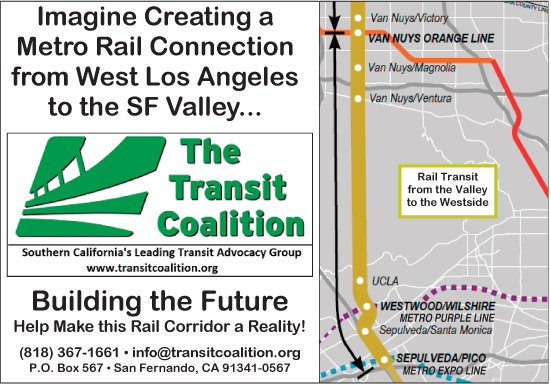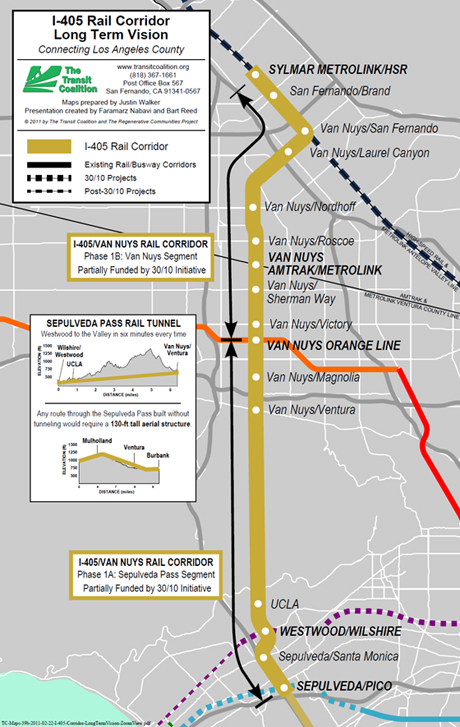By: Bart Reed
 Congress held a joint Senate-House hearing in Los Angeles earlier this year on transportation, where local leaders urged support for what was then called the Metro 30/10 Plan. Around that time, Metro launched a $2 million study on the Van Nuys corridor that would explore only a busway on Van Nuys Boulevard, between Burbank Blvd. and Plummer Street. A separate project to bring rapid transit through the Sepulveda Pass remained in the backburner of Metro plans, while being funded by Measure R. Congress held a joint Senate-House hearing in Los Angeles earlier this year on transportation, where local leaders urged support for what was then called the Metro 30/10 Plan. Around that time, Metro launched a $2 million study on the Van Nuys corridor that would explore only a busway on Van Nuys Boulevard, between Burbank Blvd. and Plummer Street. A separate project to bring rapid transit through the Sepulveda Pass remained in the backburner of Metro plans, while being funded by Measure R.

Since then, The Transit Coalition unveiled a long-term vision map focusing on particular benefits that a unified route corridor would provide along with a rail concept that would speed local commuters between the San Fernando Valley and West Los Angeles.
This project consists of two components in Measure R described above: the “San Fernando Valley I-405 Corridor Connection,” more recently described by Metro as the “Sepulveda Pass Transit Corridor,” as well as the “East San Fernando Valley North-South Rapidways Corridor,” the central component of which is the Van Nuys Corridor.
The Transit Coalition envisions the “I-405 Rail Corridor” project as the foundation for a modular, long-term conceptual line that could run from Sylmar to Cal State Long Beach, similar to the I-405 Freeway and Sepulveda / Pacific Coast Highway. Post Measure R and 30/10, the line could be extended to connect to the Green Line at LAX; another segment could bring the Green Line South Bay Extension to Long Beach; and in the distant future, an alignment could be run along the historic Pacific Electric right-of-way in the densest section of the South Bay beach cities.

Commuters who can't avoid gridlock on the I-405 Freeway get the biggest bang for the buck with the 30/10 Plan (now folded into the national initiative America Fast Forward): the Sepulveda Pass segment is the last item in the Measure R schedule, so commuters would experience its benefits a full 20 years sooner.
If Metro moves forward by building a direct rail tunnel from the San Fernando Valley to Westwood, commuters could go from Ventura Boulevard to Wilshire Boulevard in just six minutes. This project would be the linchpin of the original 30/10 Plan, ultimately connecting Metrolink, Orange Line, Wilshire subway, and Expo rail together.
The I-405 Rail Corridor would give commuters from Santa Clarita, Simi Valley, and the Antelope Valley an alternative that can be faster than driving to job centers in Westwood, Century City, and Santa Monica.
The I-405 Rail Corridor Long Term Vision map is the first of its kind identifying a specific route for the project, for which Metro intends to begin the scoping process later this year. It combines the Sepulveda Pass and Van Nuys segments from Measure R to create one seamless project that not only provides benefits to people along the route, but also extends rapid transit within reach of suburban residents, linking the network together.
The I-405 Freeway carries over 300,000 trips across the Sepulveda Pass every day. Two of the nation's top freeway interchanges by traffic volume, I-405 / I-10 and I-405 / US-101, are along this corridor, showing the potential for ridership.
The Transit Coalition has an active discussion board on the I-405 Rail Corridor project, where commenter's unanimously agree that (1) the Valley-Westside corridor should be studied as a whole, and (2) that the dramatic time savings are the greatest benefit that this project would yield. You can participate in these discussion boards at www.transitcoalition.org

|